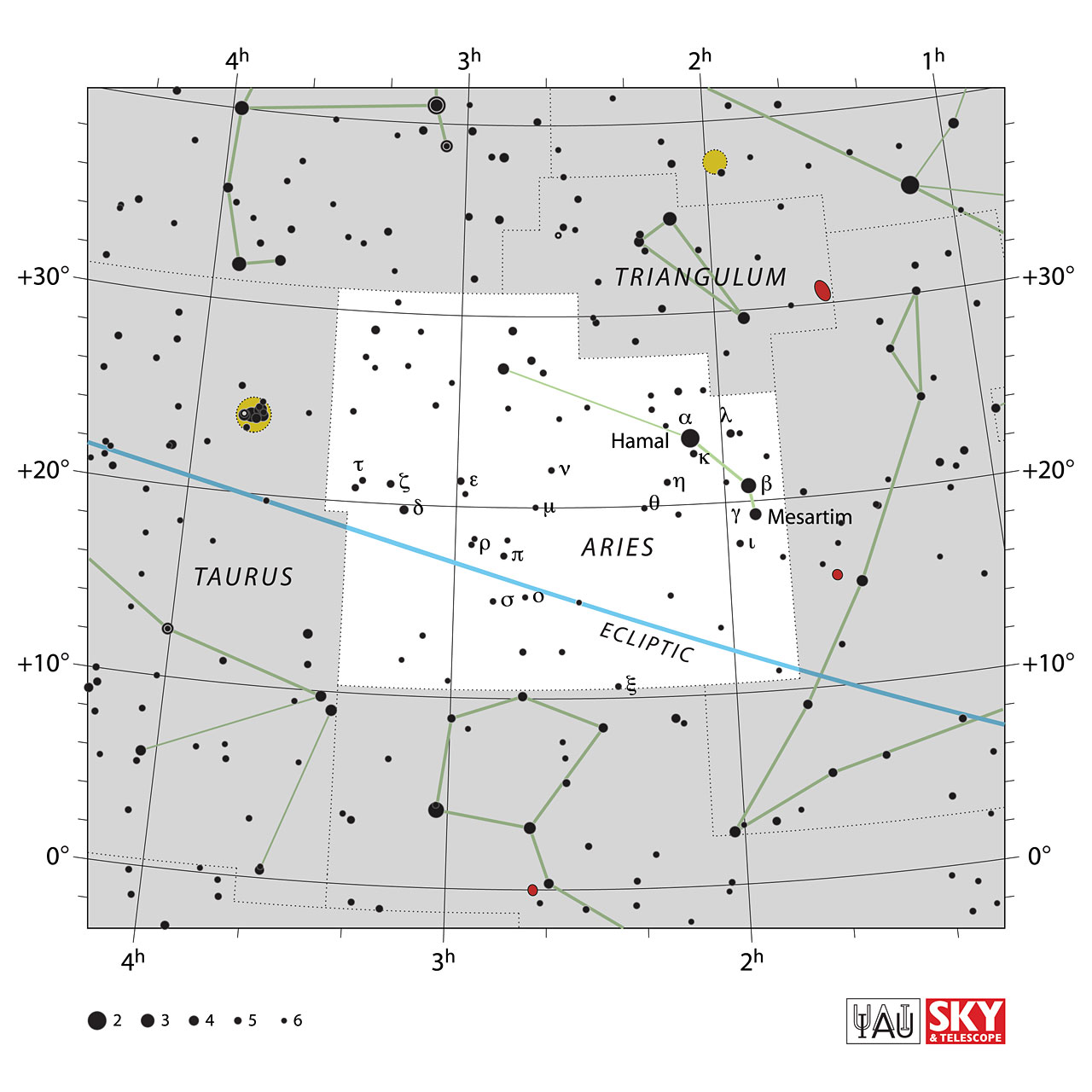Aries


Aries is a medium-sized zodiacal constellation which represents a ram in classical mythology. It is one of the 48 constellations described by the 2nd century astronomer Ptolemy
It is visible in the northern sky in the months around October, and is dominated by the two second-magnitude stars Hamal and β-Ari. These mark the two horns of the ram.
Aries lies well away from the plane of the Milky Way and does not contain any open or globular clusters. It is home to many faint galaxies, though.
In Greek mythology, Athamas, the legendary king of Thessaly, had two children, Phrixus and Helle. He had remarried and Ino, the children’s stepmother, began to treat them very badly. They were treated so cruelly that Hermes took pity on them and sent a magical ram to take them away and escape their stepmother’s wrath. Mounted on the ram’s back, the children flew over land and sea to the east. Unfortunately, Helle failed to get a good hold on the fleece of the ram and as they flew over the strait that separates Europe and Asia, she fell off and was drowned in the sea far below. That sea is called Hellespont to this day in honor of her memory. Phrixus landed safely at Colches, which is on the edge of the Black Sea. In gratitude for his safe deliverance, Phrixus sacrificed the ram and gave its Golden Fleece to the king of that country. In honor of the ram’s great sacrifice in saving the children, Zeus placed the ram’s constellation, Aries, in the night sky.
In ancient Egyptian astronomy, Aries was associated with the god Amon-Ra, who was depicted as a man with a ram’s head and represented fertility and creativity. This is one of the reasons why the sign is associated with the bull. Because it was the location of the vernal equinox, it was called the “Indicator of the Reborn Sun”
the first lunar mansion in Hindu astronomy was called “Aswini”, after the traditional names for Beta and Gamma Arietis, the Aswins. Because the Hindu new year began with the vernal equinox, the Rig Veda contains over 50 new-year’s related hymns to the twins, making them some of the most prominent characters in the work. Aries itself was known as “Aja” and “Mesha” ಮೇಷ
In Hebrew astronomy Aries was named “Taleh”; it signified either Simeon or Gad, and generally symbolizes the “Lamb of the World”. The neighboring Syrians named the constellation “Amru”, and the bordering Turks named it “Kuzi”.
This constellation gives its name to the point in the sky where the Sun crosses the equator at the March equinox, known as the First Point of Aries. Historically, the Sun once lay in the constellation of Aries at the time of the equinox, but the phenomenon of the precession of the equinoxes means that it now lies nearly 30° away, in Pisces.
Aries being a zodiac constellations has its own symbol ![]() and emoji ♈.
and emoji ♈.
Aries contains:
-
Stars
- Hamal (mag 2.0)
- Sheratan (mag 2.7)
- c-Ari (mag 3.6)
- Botein (mag 4.3)
- HD 20644 (mag 4.5)
- 39-Ari (mag 4.5)
- ε-Ari (mag 4.6)
- 35-Ari (mag 4.6)
- Mesarthim (mag 4.6)
- λ-Ari (mag 4.8)
- γ²-Ari (mag 4.8)
- ζ-Ari (mag 4.9)
- 14-Ari (mag 5.0)
- κ-Ari (mag 5.0)
- τ²-Ari (mag 5.1)
- ι-Ari (mag 5.1)
- ε-Ari (mag 5.2)
- UV Ari (mag 5.2)
- η-Ari (mag 5.2)
- 33-Ari (mag 5.3)
- π-Ari (mag 5.3)
- τ-Ari (mag 5.3)
- ν-Ari (mag 5.5)
- 52-Ari (mag 5.5)
- ξ-Ari (mag 5.5)
-
Open ClustersNone
-
Globular ClustersNone
-
Galaxy
-
- NGC 772 (mag 10.3)
- NGC 972 (mag 11.3)
- NGC 821 (mag 11.3)
- NGC 1156 (mag 11.7)
- NGC 877 (mag 11.8)
- NGC 976 (mag 12.4)
- NGC 803 (mag 12.4)
- NGC 935 (mag 12.8)
- NGC 680 (mag 13.0)
- NGC 1012 (mag 13.1)
- NGC 1029 (mag 13.1)
- NGC 1134 (mag 13.2)
- NGC 1036 (mag 13.2)
- NGC 678 (mag 13.3)
- NGC 673 (mag 13.3)
- NGC 776 (mag 13.4)
- NGC 770 (mag 13.5)
- NGC 691 (mag 13.5)
- NGC 1056 (mag 13.5)
- NGC 992 (mag 13.5)
- NGC 871 (mag 13.6)
- NGC 932 (mag 13.7)
- NGC 695 (mag 13.7)
- NGC 694 (mag 13.7)
- NGC 820 (mag 13.7)
-
View Aries in 3D 
Source: Wikipedia, in-the-sky.org
Image Courtesy: Sky&Telescope & IAU, Illustration Images linked from Urania's Mirror on Wikmedia Commons by Sidney Hall
Image Courtesy: Sky&Telescope & IAU, Illustration Images linked from Urania's Mirror on Wikmedia Commons by Sidney Hall
